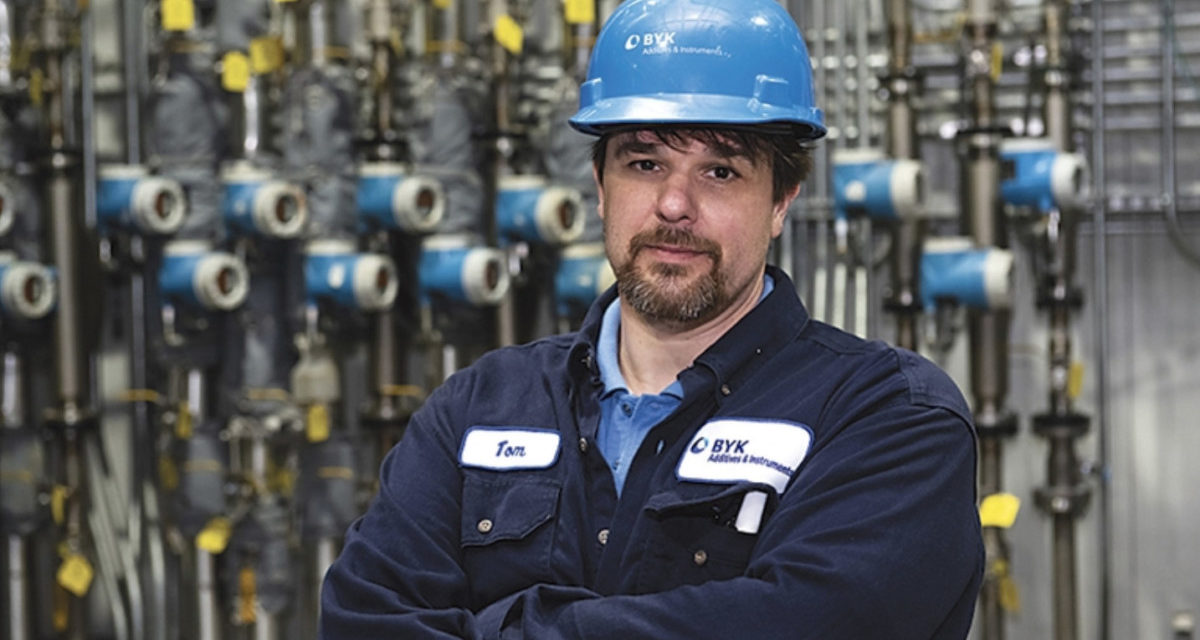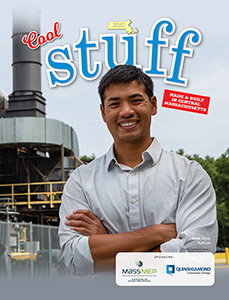Wallingford Public School Superintendent Salvatore Menzo was trying to answer a simple question: How could he expose his nearly 6,000 elementary-secondary school students to career options and training that don’t require a college degree, while also encouraging them to hone their analytical and critical-thinking skills — which could then be applied to their future career or trade?
In polling local businesses, Menzo says he came to fully realize how great the need was, particularly among manufacturers, for trainees with exactly those basic skills whom companies could employ and fortify with science, technology, engineering and math-related (STEM) training to create a new generation of skilled toolmakers, machinists, engineers, quality inspectors, among other positions.
What he and others helped develop — with ardent support from manufacturers, town government, schoolkids and their parents, and various local nonprofits and support groups — was a townwide STEM initiative that aims to expose more students, as well as un- and underemployed residents, to instruction and activities that hone their thinking skills while also exposing them to science, technology, engineering and math careers and trades.
The so-called “STEM Town’’ initiative is a public-private partnership of sorts that officially launched last May and may be one of the most ambitious and outside-the-box concepts for confronting the state’s manufacturing jobs shortage.
In fact, some state lawmakers say Wallingford’s STEM Town may serve as a model for a statewide program, though it could take years to measure its true, longer-term impact.
So, what exactly is STEM Town? Simply put, supporters say it’s an ambitious collection of instructional goals, curricula and classes centered on making students — youth and adults — more adept at framing problems and designing solutions using their STEM-based learning and critical-thinking skills. Occasional district-wide design challenges promote development of those skills, Menzo said.
It also involves participation in internships and apprenticeships.
Students even hold seats, alongside local employers, on Wallingford’s STEM Town Steering Committee, which has a hand in STEM curricula, he said.
The initiative also goes beyond the traditional grade-school classroom. For example, it incorporates workforce-development organizations that retrain Wallingford’s un- or underemployed adult residents to work at dozens of the town’s manufacturing employers.
Meantime, local support groups, such as the Boys & Girls Club and YMCA, promote STEM in their before and after-school programs and their vacation and summer camps.
“The challenge is,’’ said Menzo, a West Hartford resident who has led Wallingford’s school system since 2009, “we’re trying to address the challenge of workforce development at various levels. We need to make sure our students have an understanding of careers, not just in manufacturing.’’
“We view it as an ecosystem within our community,’’ he added. “We have to identify the strengths and weaknesses of that ecosystem.”
STEM Town’s birth occurred against the backdrop of a projected need among Connecticut manufacturers, including East Hartford’s Pratt & Whitney and Groton’s Electric Boat, for thousands of younger workers to replace ones retiring in coming years. The Connecticut Business & Industry Association estimates some 13,000 manufacturing jobs in this state are unfilled; nationally, there are about 500,000 manufacturing-job vacancies.
According to the U.S. Census Bureau, Wallingford is among Connecticut’s top production hubs, churning out $1.2 billion in manufactured goods in 2012, the latest year that data was available — ahead of Hartford, Bridgeport, New Haven and Waterbury.
All or parts of the STEM Town concept could eventually be replicated in other communities statewide confronting similar issues of educating a 21st-century workforce, according to Menzo and state Senate Republican Leader Len Fasano, whose 34th District includes Wallingford.
Fasano says he is impressed with Menzo’s passion for STEM Town, and he isn’t alone. A Wallingford businessman, whom Fasano and Menzo declined to identify, is in talks with the superintendent about ongoing financial support for the program.
“I believe in the program,’’ Fasano said. “I believe it should go statewide.’’
So does State Rep. Elizabeth Linehan, a Democrat whose district includes Cheshire, Southington and Wallingford. Linehan, chair of the General Assembly’s Committee on Children, said she will press for legislation allowing other Connecticut school systems to deploy versions of STEM Town.
Linehan and Fasano both say a statewide STEM Town initiative would require a reallocation of resources — not more money — to be effective. The prize would be a Connecticut education system better aligned with the STEM needs of today’s employers, they said.
Wallingford’s STEM Town and related initiatives were a primary reason that Linehan said she invited Menzo and his pupils to participate in her day-long Student-Manufacturer Connection Fair in April that drew some 500 grade-school students and a smaller number of manufacturing employers to the state Capitol.
The fair, Linehan said, was a response to pleas from her manufacturing constituents “to get them in front of young people.’’ The persistent stereotype of factory floors as dirty, smelly and dangerous, rather than bright, clean and sterile places of today, is one manufacturing employers are eager to break, she said.
Townwide buy-in
Wallingford attorney and City Council chair Vincent Cervoni says he supports the school system’s STEM Town initiative.
“We don’t see any downside to it,’’ said Cervoni, who worked for a New Haven die-cast maker while in college. “It’s good for Wallingford because we have a lot of skilled-manufacturing in town.’’
The initiative, he said, serves a dual role of providing pre-apprenticeship and pre-skills training to a fresh cadre of younger workers, while exposing the city and region to the products, jobs and other positives flowing out of Wallingford factories.
Tim Ryan, Wallingford’s director of economic development, sees plenty of benefits to its employers.
“It’s very important that businesses know we understand the challenges confronting them,’’ Ryan said. “More than that, we’re working aggressively to address them.’’
William “Bill” Villano, president/CEO of the Workforce Alliance/American Job Center, which covers Middlesex and New Haven counties, says Connecticut’s shrinking, aging population is forcing other communities to rethink their education and skills-training efforts.
While Wallingford, so far, is out front with STEM Town, Verano said high schools in a growing number of towns, including Chester, Essex, Hamden and Meriden, are deploying STEM-based skills training in their classrooms.
His group is also working with Wallingford on its STEM Town initiative, providing training to adults looking for a new career opportunity.
Meantime, in early May, Workforce Alliance began accepting applications from state residents 18 and older for its summer “Skill Up for Manufacturing’’ training program at Middletown’s Vinal Technical High School. A second skills-training session runs from June 17 to July 22, in New Haven.
STEM Town success story
Wallingford resident Thomas Nichols, 47, who spent the last five years doing maintenance for a local apartment complex, is a STEM Town beneficiary. Married with two middle-schoolers and a degree in graphic design, Nichols “saw the handwriting on the wall’’ regarding the future of that job, so he turned to manufacturing.
“I’ve always liked working with my hands,’’ he said.
Nichols enrolled last fall in a six-week, manufacturing-training program run by two STEM Town participants — Workforce Alliance and HUBCAP Wallingford, which promotes lifelong adult learning. He was tested for his math and reading skills. Then, each Thursday, he would meet with four Wallingford manufacturers who spoke to him and other participants about their companies.
HR officials from those companies helped Nichols and his classmates create resumes and coached them in answering employers’ questions in mock job interviews. In the final session, students underwent live job interviews, to determine if they were hireable.
Nichols landed a job in January with Germany’s BYK Co., whose Wallingford plant’s capacity expanded five years ago for making additives that give paints and coatings their hue and physical properties.
Nichols was BYK’s first STEM Town-related hire and was among nine of the 13 people who landed jobs after graduating from Workforce Alliance’s manufacturing-training program.
“It’s taken some getting used to,’’ Nichols says of his new job. “Hourly pay is better than I was getting.’’
BYK’s benefits are great, too, he said, especially the free pairs of $125 workboots the company provides its full-time workers.
Bridget Bozzi, BYK’s head of human resources, said her company values STEM Town “because it helps promote jobs within the community and it helps us recruit.,”
Nichols says his only regret is that he didn’t pursue a manufacturing job sooner. He works, he said, with guys half his age.
To Millennials weighing a job or career in manufacturing, or other trades, “I’d say, ‘go for it,’ ’’ Nichols said. “ … I’ve always told my kids do what you love to do. If it’s not a job you want, figure out how to do [for a living] what you love to do.’’



